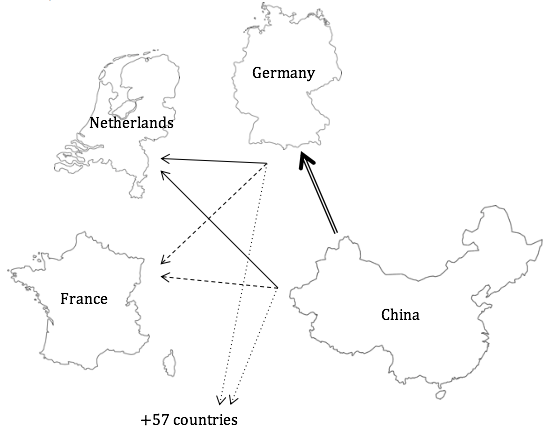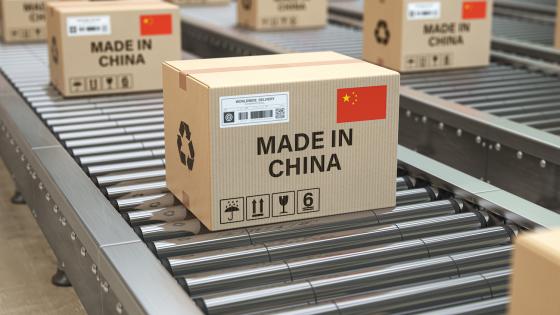During the past two decades, China’s manufacturing exports to advanced industrialised democracies have grown enormously. China became the world’s largest exporter of goods, as a result of its liberalisation of product and financial markets, its productivity growth, and its WTO accession in 2001.
What are the employment consequences of China’s rapid exports growth for workers in OECD countries, given China’s enormous volume of low-wage labour? This question has become even more imperative given the recent initiatives of the Trump administration and the EU to raise tariffs on Chinese imports (Legge et al. 2018), as well as claims that exposure to Chinese imports can contribute to political nationalism and populism (Colantone and Stanig 2017). Recent studies reveal strong distributive effects of the rise of China on the global economy in single-country studies, in particular in the US (Autor et al. 2013, Acemoglu et al. 2016), and for instance in Norway (Balsvik et al. 2015).
We analyse the developments in sectoral employment size and the share of hours worked by low-skilled workers in 17 sectors within manufacturing across 18 OECD countries between 1990 and 2007 (Thewissen and Van Vliet forthcoming). By doing so, we aim to provide a general assessment of labour market outcomes of Chinese trade competition across a broad group of OECD countries with diverse labour market institutions. Furthermore, we extend our analysis of trade effects by taking into account Chinese competition in foreign export markets.
Literature and hypotheses
Increased trade competition stemming from China may affect workers in OECD countries in two ways. First, Chinese imports in OECD countries can substitute for the domestic production of goods, resulting in a reduced labour demand. Second, Chinese exports can also affect sectors by generating increased competition in the foreign market sectors where firms sell their products. As an example, it could be that a German manufacturer has a large market share in France, but sees its exporting opportunities to France decline as France substitutes German imports for Chinese products.
Within sectors, mainly the low-skilled employees in exposed manufacturing sectors in OECD countries are likely to be affected by Chinese exports, given the relative abundance of low-skilled labour in China. Furthermore, high-skilled workers may benefit from Chinese trade competition, as it can trigger firms to hire more high-skilled workers to increase their productivity (Bloom et al. 2016).
Technological change is another often-mentioned driver of employment levels and inequality. It can substitute for routine occupations mainly found in the low and middle parts of the distribution within manufacturing, whilst it can complement high-skilled workers (Michaels et al. 2014, Autor et al. 2015).
Data
We make use of standardised sectoral level time series data from EU-KLEMS (O’Mahony et al. 2011) complemented with other sources mainly from the OECD, for 17 sectors across 18 OECD countries between 1990-2007. We distinguish between (direct) import competition and foreign export market competition. We measure Chinese import competition as the value of the total imported goods from China as a share of the value added for each sector. In Figure 1, import competition is indicated for a German manufacturing sector by the double lined arrow on the right-hand side pointing upwards, which shows the exposure to import competition for this industry, coming from (direct) imports from China.
Figure 1 Import competition and competition in foreign export markets illustrated for a German industry
Chinese competition in export markets is defined as the size of Chinese exports relative to a country’s exports to a partner country, weighted by the relative importance of this partner country, all at the sectoral level. In Figure 1, the pivoted arrows on the left-hand side together show the amount of export competition. The two solid arrows are the exports from the German and Chinese sector industry to the same industry in the Netherlands. The difference between these Chinese and German exports to the Netherlands, weighted by total exports to the Netherlands, measures the amount of export competition the German sector experiences from China in the Netherlands. This is calculated for more countries, such as France (the dashed lines), and 57 other countries (the dotted lines).
Technological change is measured as capital compensation in information and communication technology as a share of sectoral value added. Furthermore, we include a large set of labour market institutions that can affect the employment distribution (OECD 2011).
Findings
Figure 2 shows that China is becoming an increasingly important trading partner for advanced industrialised countries. Pooling across sectors and countries, trade exposure increased substantially between 1990 and 2007. The export competition measure shows negative values that become smaller over time. This indicates that in foreign markets, the value of the exports from our sample of OECD countries is on average larger than the value of the Chinese exports, but Chinese firms are catching up rapidly.
Figure 2 Evolution of Chinese imports and exports competition
Using error correction and partial adjustment models, we find employment declines in sectors that are more exposed to imports from China (OECD 2017). Furthermore, within sectors, employment effects seem not to be equally shared across skill levels. The results suggest that low-skilled workers bear the brunt of the substitution of domestic production by Chinese imports, as well as of the increased competition from China in foreign export markets. Furthermore, our results indicate a negative association between technological change and the relative employment size, as well as with the relative employment position of low-skilled workers worsens. Dynamic simulations suggest that the size of these associations is quantitatively meaningful. For instance, asector experiencing a high (at the 95thpercentile) shock in exposure to Chinese export competition scenario has a predicted share of hours-worked by the low-skilled that is four percentage points lower than a sector experiencing a low (5thpercentile) shock after ten years (16.5% versus 20.5%).
All in all, we find that China’s rapid rise on the global economic stage is associated with lower manufacturing employment levels and disproportionally fewer hours worked by low-skilled workers. This suggests that previous findings from single-country studies can be generalised to a broader set of 18 OECD countries with diverse labour market institutions.
Authors’ note: This work was conducted before Stefan Thewissen joined the OECD. The views reflect those of the author and not necessarily those of the OECD or its member states.
References
Acemoglu, D, D Autor, D Dorn, G Hanson, and B Price (2016), “Import Competition and the Great US Employment Sag of the 2000s”, Journal of Labor Economics 34:S1, S141-S198.
Autor, D, D Dorn, and G Hanson (2013), “The China Syndrome: Local Labor Market Effects of Import Competition in the United States”, American Economic Review 103(6): 2121-2168.
Autor, D, D Dorn, and G Hanson (2015), “Untangling Trade and Technology: Evidence from Local Labor Markets”, The Economic Journal 125(584): 621-646.
Balsvik, R, S Jensen, and K Salvanes (2015), “Made in China, Cold in Norway: Local Labor Market Effects of an Import Shock”, Journal of Public Economics 127: 137-144.
Bloom, N, M Draca, and J Van Reenen (2016), “Trade Induced Technical Change? The Impact of Chinese Imports on Diffusion, Innovation, and Productivity”, Review of Economic Studies 83(1): 87-117.
Colantone, I and P Stanig (2017), “Globalisation and Economic Nationalism”, VoxEU 20 February.
Legge, S, P Lukaszuk and S Evenett (2018), “Raising Tariffs on China without Grabbing Headlines”, VoxEU.org, 17 April.
OECD (2011), Divided We stand: Why Inequality Keeps Rising.
OECD (2017), "How Technology and Globalisation are Transforming the Labour Market", in Employment Outlook 2017, pp. 81-124
O’Mahony, M and M Timmer (2009), “Output, Input and Productivity Measures at the Industry Level: the EU KLEMS Database”, Economic Journal, 119(538).
Thewissen, S and O van Vliet (forthcoming), “Competing With the Dragon: Employment Effects of Chinese Trade Competition in 17 Sectors Across 18 OECD Countries”, Political Science Research and Methods doi:10.1017/psrm.2017.35.





